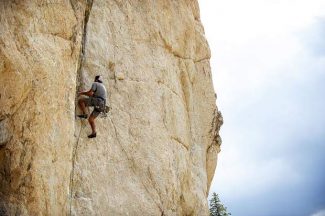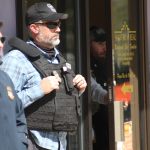Obituary: John Gilmore
May 9, 1929 – June 7, 2025
John Frederick Gilmore, born May 9, 1929, in DeKalb, Illinois, to Helen and Bruce Gilmore, died June 7, 2025, in Grand Rapids, Michigan, well-tended by Hospice, caregivers, family, and friends.
John Frederick Gilmore, christened “Jack,” a confident upstart from the beginning, changed his name to “John” at age 7 because he felt it sounded more businesslike. Also known as Daddy Dear, Papa Bear and Santa Claus all year round, he was always “JFG,” never, ever “grandpa” to his grandchildren.
He was a loyal, supportive friend, patron, and founder of the arts–particularly opera, symphony, theater–in Grand Rapids, Chicago, and Colorado. A brilliant, savvy, visionary businessman, he was the “Honorable Leader” of the Gilmore (restaurant and hotel) Collection which he headed with his son Gregory. He was a marathon runner who swore by “the famous Gilmore double knot” to keep his kickers on throughout the races. A voracious reader of great, ponderous, often arcane books, he was a devotee of the Wall Street Journal and many periodicals. He read widely in U.S. and world history, remembering great swaths of what he read and dispensing quotes when needed. He curated a personal library that a friend, a former president of Grand Valley State University, called the most impressively extensive he had ever seen. Self-taught, a true autodidact, he claimed “the more you know, the more you realize you don’t know.”
Relentlessly and perversely frugal, he could also be fantastically, considerately generous. A collector of fine art, he was a lover of wine, women, and song, specializing, as he might say, in “training” the second. Never ordinary, often extraordinary, he was charming and charismatic, an eloquent speech maker and whiz-bang toastmaster.
A survivor of military school and a wintertime stint in the U.S. Army in Anchorage, Alaska, he would point out that he also survived the school of hard knocks and serious heartbreak. He identified with Sisyphus, as the “pusher of the rock up the hill,” enjoying the sport of it and “the mental fortitude” it took, rather than lamenting the futility of the effort. JFG was a wild, whooping skier of mountains and a man who enjoyed life after work and off the slopes. An exuberant reveler well into his eighties, he would be the last to leave the dance floor, “hoofing it up” and “tripping the light fantastic,” because, he would say, he had been “overserved and under-supervised,” more than likely because he had “fallen in with some bad company”–always, and ever, the life of the party.
A keen observer and student of human psychology, he was enormously and confoundingly complex– acutely sensitive, surprisingly sentimental, but stoic. He was sometimes introspective, but also steadfastly and inflexibly opinionated, a curmudgeon with a heart that could be a Midas trove. An epicurean who complained often of recipes being too sweet, once notoriously yelling “too much sugar,” while lofting his daughter’s homemade rhubarb pie off his deck to the prowlers in the undergrowth in the hillside below, his Machiavellian cackle echoing across Reeds Lake. Shouldn’t the baker have known? Be that as it may, he ate Crispy Creme donuts (“sinkers”) as if they were going out of style. He cherished his copy of The Art of Contrary Thinking, and embodied the title, writ large.
He was a post card writer who invariably promised “long letter to follow,” as well as a thorough note- taker and legal pad user. He was a romantic and a dreamer, tempered and always girded up by pragmatism. A spurner of gifts, relishing organization and a strange asceticism, often wearing clothing held together with pins sixty- years-old, he was a subscriber to having little and being dead ready.
He was a preacher of fiscal prudence and disciplined responsibility tutored by “hard lessons via the pocketbook,” lessons learned and relearned, he would say, generally “in a moment of weakness” when he was too trusting of human decency and honor.
As a businessman, he was a gutsy, undeterred, intrepid, optimistic deal-maker who loved the pursuit of the deal as much as the profit. He often said that he eyed the horizon looking for “his ship to come in.” He often said to children, “I may be short, but I am a giant among men.” His legacy proves that. The Grand Rapids Press once profiled him against the graphic of a monopoly board featuring the many properties owned or developed by him and his company, Investors’ Incentives. Among some of his holdings were The Ledyard Building, The Oakwood Manor, and The Federal Square Building, for which he commissioned the eagle sculpture watching over its entrance. The Press also delightfully chronicled his purchase of a building valued at $375,000 for $100 and some years-long creative financing. Some of his projects spawned the transformation of the communities around them. In the 1960s, he repurposed part of the then defunct Ramona Amusement Park in East Grand Rapids to build a Jacobson’s Department store, a retail centerpiece of what came to be known as Gaslight Village. In the 1970s, he created the Thornapple Village Shopping Center in Ada, featuring The Thornapple Village Inn, an upscale venue that served as a foundational element of The Gilmore Collection.
During the same period, he also turned his developer’s eye to Colorado, purchasing and reopening one of Aspen, Colorado’s, finest landmarks, The Hotel Jerome, a project that induced him to move his family to Aspen, where they, for a time, lived in the hotel and enjoyed, what was then, the small-town life of a mountain haven. Although he later sold the Jerome, he sustained his interest in Colorado and in historical architecture with the purchase and development of The Redstone Inn, a hotel located in the Crystal River Valley near Aspen and listed on the National Register of Historic places.
Though pleased with his business developments, his greatest source of pride was his family, which will, in turn, greatly miss this world traveler who left on his last great adventure on June 7, 2025, recalling memories of their lives with him and, very likely, quoting him now and again.
He was proceeded in death by his parents, Helen and Bruce W. Gilmore, by his brother Gene J. Gilmore and his granddaughter Ariel Hettinga. He is survived by his ex-wife Barbara F. Gilmore (Bobbi), whom he extolled for her ability to run a beautiful home and be an excellent mother and cook. He credited her with being “a hostess with the mostest,” whom he could call on to dazzle, feed, and graciously entertain opera casts, lawyers, doctors, bankers, investors, friends, and family.
He is also survived by his daughter Kimberly (Donald) Hettinga; son Scott (Karen) Gilmore; son Gregory (Jacqueline); daughter Tamara (Frank) Woods; daughter Julie Gilmore; many grandchildren and great grandchildren; and by his sister Ruth Jo/Shri Lehka Gilmore; his sister Laurinda Gilmore Graves; by his brother Bruce E. Gilmore; and by dear friends Bob Woodhouse and his partner Jodi Ter Molen.
Base jumper rescued after accident at Aspen’s Grottos
Mountain Rescue Aspen has successfully rescued a base jumper who crash-landed at the base of the Grotto Wall climbing area on Independence Pass Saturday.







